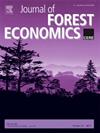Valuation of Large Carnivores and Regulated Carnivore Hunting
IF 0.7
4区 农林科学
Q3 ECONOMICS
引用次数: 3
Abstract
Large carnivores are keystone species but represent economic costs to hunters. In Sweden, carnivore territories generally overlap with hunting areas, and as a result, conflicts occur because of the competition for prey. The wolf, lynx, and brown bear are protected species by law but are hunted when authorities allocate license hunting quotas. The aim of these quotas is to limit carnivore numbers. We estimate a hedonic model using ordinary least squares to address the effect of large carnivore occurrence on hunting lease prices by accounting for the presence of license hunting quotas for predators. This result is compared with the least absolute deviation estimations, which reduce the influence of outliers in the survey data. To isolate the effect of carnivores on hunting lease prices, we use snow depth and forest productivity as proxy variables for game harvest in the absence of carnivores. Our results show that lynx and wolf presence reduce hunting lease prices, but lynx presence shows higher significance and robustness. Based on median regressions, the marginal implicit price of an additional wolf territory is about 15% larger than that of an additional lynx territory. In contrast, we found no conclusive evidence that bear abundance directly affects hunting lease prices, but regulated bear hunting is found to have a positive and significant impact on hunting leases, suggesting indirect positive net benefits of increased brown bear abundance.大型食肉动物的估价和受管制的食肉动物狩猎
大型食肉动物是关键物种,但对猎人来说是经济成本。在瑞典,食肉动物的领地通常与狩猎区重叠,因此,由于争夺猎物而发生冲突。狼、山猫和棕熊是受法律保护的物种,但当当局分配狩猎许可证配额时,它们就会被猎杀。这些配额的目的是限制食肉动物的数量。我们使用普通最小二乘法估计了一个享乐模型,通过考虑捕食者许可狩猎配额的存在,来解决大型食肉动物的出现对狩猎租赁价格的影响。将该结果与最小绝对偏差估计进行比较,从而减少了调查数据中异常值的影响。为了分离食肉动物对狩猎租赁价格的影响,我们使用雪深和森林生产力作为在没有食肉动物的情况下狩猎收获的代理变量。我们的研究结果表明,山猫和狼的存在降低了狩猎租赁价格,但山猫的存在表现出更高的重要性和稳健性。基于中位数回归,额外的狼领地的边际隐含价格比额外的山猫领地高出约15%。相比之下,我们没有发现确凿的证据表明熊的数量直接影响狩猎租赁价格,但受监管的熊狩猎对狩猎租赁有积极而显著的影响,这表明棕熊数量增加带来了间接的正净收益。
本文章由计算机程序翻译,如有差异,请以英文原文为准。
求助全文
约1分钟内获得全文
求助全文
来源期刊

Journal of Forest Economics
农林科学-林学
CiteScore
1.70
自引率
0.00%
发文量
16
审稿时长
>36 weeks
期刊介绍:
The journal covers all aspects of forest economics, and publishes scientific papers in subject areas such as the following:
forest management problems: economics of silviculture, forest regulation and operational activities, managerial economics;
forest industry analysis: economics of processing, industrial organization problems, demand and supply analysis, technological change, international trade of forest products;
multiple use of forests: valuation of non-market priced goods and services, cost-benefit analysis of environment and timber production, external effects of forestry and forest industry;
forest policy analysis: market and intervention failures, regulation of forest management, ownership, taxation;
land use and economic development: deforestation and land use problem, national resource accounting, contribution to national and regional income and employment.
forestry and climate change: using forestry to mitigate climate change, economic analysis of bioenergy, adaption of forestry to climate change.
 求助内容:
求助内容: 应助结果提醒方式:
应助结果提醒方式:


